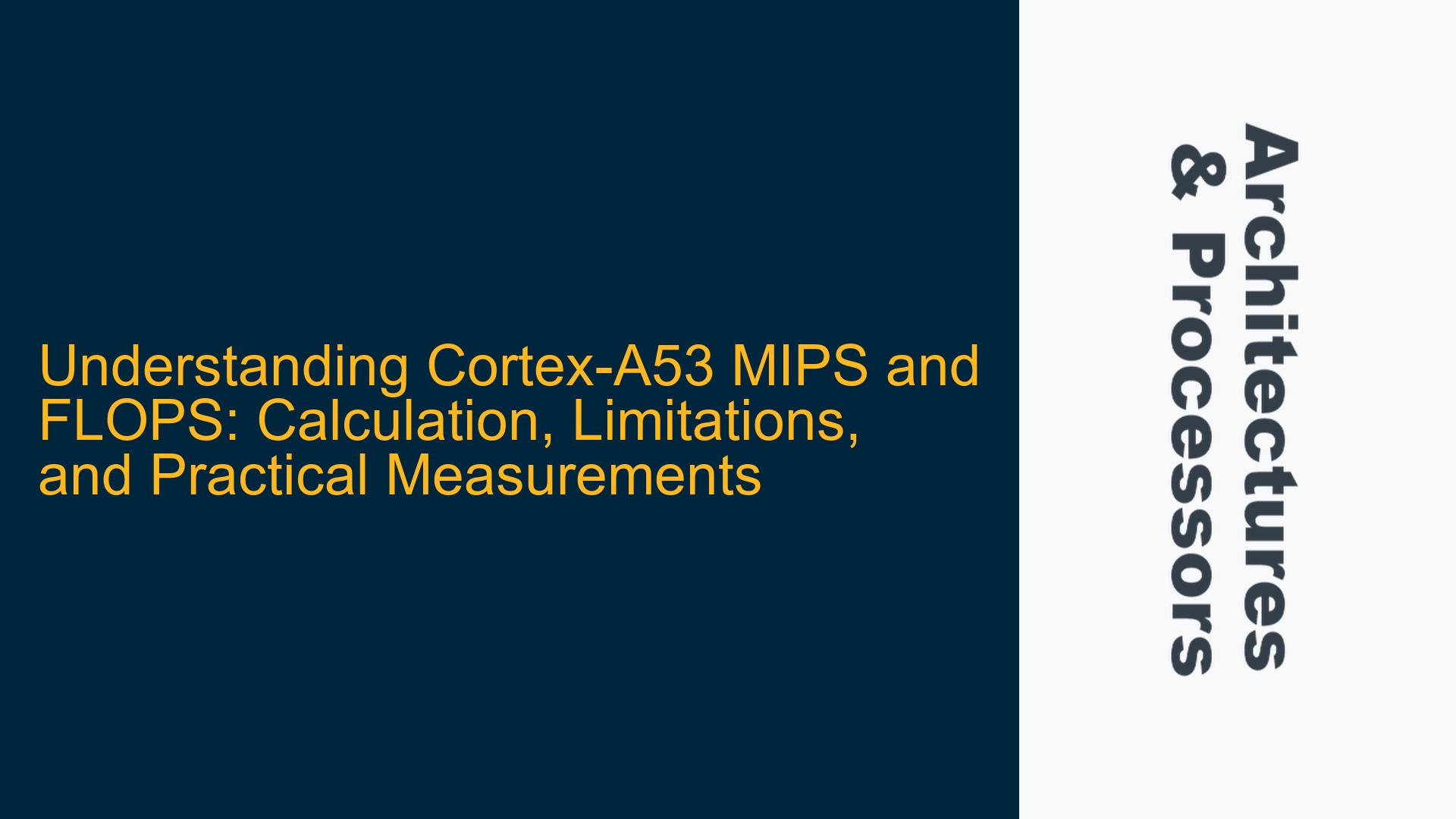Cortex-A53 MIPS Calculation and Its Limitations
The Cortex-A53 is a highly efficient ARMv8-A processor core designed for low-power applications, often found in mobile devices and embedded systems. One of the key metrics used to evaluate processor performance is MIPS (Millions of Instructions Per Second), which provides a theoretical upper bound on the number of instructions a processor can execute in a given time frame. However, MIPS as a performance metric has significant limitations, especially when applied to modern processors like the Cortex-A53.
The Cortex-A53 is a dual-issue, in-order execution processor, meaning it can issue up to two instructions per clock cycle under optimal conditions. This dual-issue capability is a critical factor in calculating its theoretical MIPS. To derive the MIPS value, you multiply the number of instructions issued per cycle by the processor’s clock frequency. For example, if a Cortex-A53 core is running at 1.5 GHz, the theoretical maximum MIPS would be:
[
\text{MIPS} = \text{Instructions per cycle} \times \text{Frequency (in MHz)} = 2 \times 1500 = 3000 \text{ MIPS}
]
However, this calculation represents an ideal scenario. In real-world applications, the actual MIPS value is often lower due to various factors such as pipeline stalls, cache misses, branch mispredictions, and dependencies between instructions. Additionally, the Cortex-A53’s in-order execution architecture means it cannot reorder instructions to maximize throughput, further reducing its effective MIPS in complex workloads.
Another limitation of using MIPS as a performance metric is its lack of context. MIPS does not account for the type of instructions being executed, the efficiency of the instruction set, or the specific workload characteristics. For instance, a processor might achieve a high MIPS value but perform poorly on tasks requiring floating-point operations or SIMD (Single Instruction, Multiple Data) processing. This is particularly relevant for the Cortex-A53, which supports ARM’s NEON technology for SIMD operations but may not fully utilize it in all scenarios.
Furthermore, MIPS does not consider the impact of memory hierarchy, I/O bottlenecks, or system-level optimizations. In embedded systems, where the Cortex-A53 is commonly used, these factors can significantly influence overall performance. Therefore, while MIPS provides a useful theoretical benchmark, it should not be the sole metric for evaluating processor performance.
Factors Influencing Cortex-A53 FLOPS and Scalar Floating-Point Performance
FLOPS (Floating-Point Operations Per Second) is another critical performance metric, especially for applications involving scientific computing, graphics rendering, or machine learning. The Cortex-A53 includes a Floating-Point Unit (FPU) that supports both single-precision (32-bit) and double-precision (64-bit) floating-point operations. However, unlike MIPS, calculating FLOPS for the Cortex-A53 is more complex due to the variability in floating-point instruction throughput and the influence of NEON technology.
The Cortex-A53’s FPU can perform one floating-point operation per cycle for scalar operations. For example, a 1.5 GHz Cortex-A53 core can theoretically achieve:
[
\text{FLOPS} = \text{Floating-point operations per cycle} \times \text{Frequency (in MHz)} = 1 \times 1500 = 1500 \text{ MFLOPS}
]
However, this calculation assumes optimal conditions with no pipeline stalls or resource contention. In practice, the actual FLOPS value can be lower due to factors such as instruction dependencies, memory latency, and the overhead of managing floating-point registers.
NEON, ARM’s advanced SIMD technology, significantly enhances the Cortex-A53’s floating-point performance by enabling parallel processing of multiple data elements within a single instruction. For example, a NEON instruction can process four single-precision floating-point operations simultaneously, effectively quadrupling the FLOPS for certain workloads. However, the original forum discussion specifically excludes NEON performance, focusing solely on scalar floating-point operations.
The lack of published data on the Cortex-A53’s scalar FLOPS performance complicates the analysis. ARM does not provide official figures for scalar floating-point throughput, leaving developers to rely on community benchmarks and empirical measurements. These measurements often reveal that the Cortex-A53’s scalar FLOPS performance is modest compared to its NEON-enhanced capabilities, making it less suitable for floating-point-intensive applications without SIMD optimization.
Additionally, the Cortex-A53’s in-order execution architecture limits its ability to hide latency in floating-point operations. Unlike out-of-order processors, which can execute independent instructions while waiting for floating-point results, the Cortex-A53 must wait for each operation to complete before proceeding. This limitation further reduces its effective FLOPS in real-world scenarios.
Practical Measurement and Optimization of Cortex-A53 Performance
Given the limitations of theoretical metrics like MIPS and FLOPS, practical measurement tools and techniques are essential for accurately assessing Cortex-A53 performance. Tools such as Linux perf provide detailed insights into actual instruction throughput, cycle counts, and performance bottlenecks. These tools enable developers to measure specific workloads and identify areas for optimization.
To measure MIPS and FLOPS on a Cortex-A53 system, follow these steps:
-
Set Up the Measurement Environment: Ensure the Cortex-A53 system is running a stable operating system with support for performance monitoring tools. Linux is a common choice due to its extensive tooling and community support.
-
Profile the Target Workload: Use Linux perf to profile the workload of interest. For example, the following command records CPU cycles and instructions executed:
[
\text{perf stat -e cycles,instructions ./workload}
]
This command provides the actual instructions per cycle (IPC) and total instructions executed, which can be used to calculate MIPS. -
Calculate MIPS: Divide the total instructions executed by the execution time in seconds. For example, if a workload executes 3 billion instructions in 1 second, the MIPS value is:
[
\text{MIPS} = \frac{\text{Total instructions}}{\text{Execution time (in seconds)}} = \frac{3 \times 10^9}{1} = 3000 \text{ MIPS}
] -
Measure Floating-Point Performance: To measure scalar FLOPS, use a workload that performs floating-point operations without NEON optimizations. Profile the workload using Linux perf and count the number of floating-point operations executed. Divide the total floating-point operations by the execution time to obtain FLOPS.
-
Optimize Performance: Based on the profiling results, identify and address performance bottlenecks. Common optimizations for the Cortex-A53 include:
- Minimizing pipeline stalls by reducing instruction dependencies.
- Optimizing cache usage to reduce memory latency.
- Leveraging NEON for SIMD floating-point operations where applicable.
-
Validate Improvements: Re-profile the workload after optimization to validate performance improvements. Compare the new MIPS and FLOPS values to the baseline measurements to quantify the impact of optimizations.
By combining theoretical calculations with practical measurements, developers can gain a comprehensive understanding of Cortex-A53 performance and make informed decisions about system design and optimization. While MIPS and FLOPS provide useful benchmarks, they should be interpreted in the context of specific workloads and system configurations to ensure accurate performance evaluation.
In conclusion, the Cortex-A53’s MIPS and FLOPS performance are influenced by its dual-issue, in-order execution architecture, scalar floating-point capabilities, and support for NEON technology. Theoretical calculations provide an upper bound, but practical measurements are essential for accurate performance assessment. By leveraging tools like Linux perf and applying targeted optimizations, developers can maximize the Cortex-A53’s potential in their applications.






